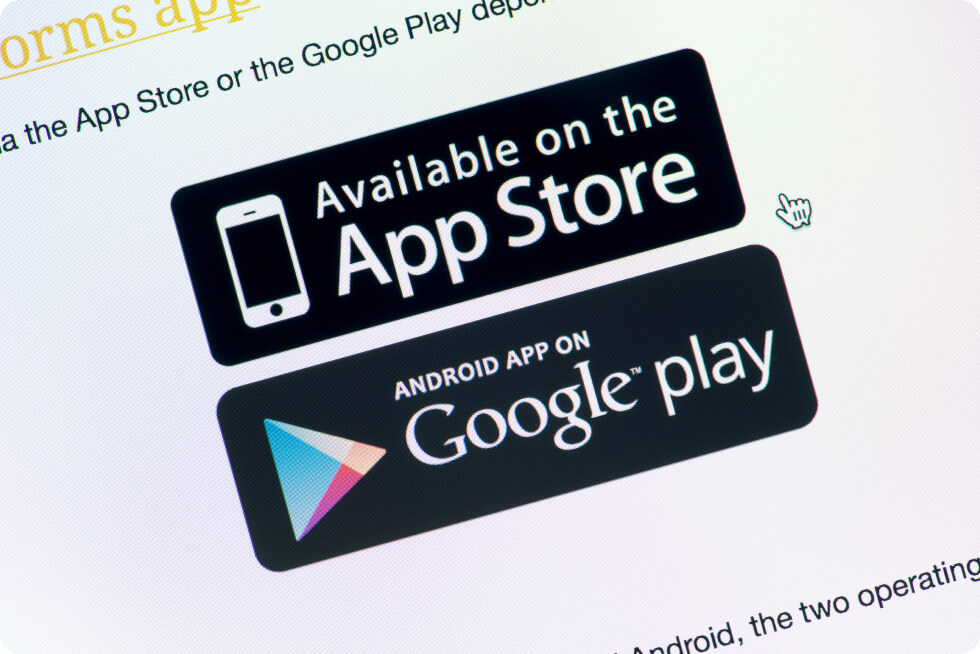
If your business wants to learn how to create an app, you’re likely wondering what technical skills, technologies, and platforms are the most important to learn. While technical skills and good technology choices are critical in developing world-class mobile apps, several other vital tasks and considerations are essential in creating a successful app.
Mobile app development requires more than just technical skills. To create an app that meets users’ expectations provides a valuable service, and outpaces your competitors, you need a clearly defined strategy and approach, as well as the technical skills and breadth of knowledge that a software development company can provide.
If your business wants to know everything about the mobile app development process, this post will help you. However, this post will not teach you the technical skills required to create your own app. Learning the ins and outs of the entire development process requires hands-on experience and specialized training, which can take years to master.
However, while we won’t teach you the technical side of application development, we will explain how your business can take an initial idea and create a mobile app that pleases users and achieves your business goals. Let’s explore some vital tasks and considerations your business needs to make to create an app.
How To Create an App: The Vital Tasks and Considerations
Building a successful app begins long before a single line of code is written. In fact, without a solid foundation to inform the direction of your company’s app development project, it doesn’t matter how good your code is; it will be challenging to realize your idea fully.
Ensure that your business fully considers the following to create your own app that will be successful:
- Define your app idea
- Understand your target audience
- Define key functions and popular app features
- Research your competitors
- Choose a development approach
- Invest in security and maintenance
- Don’t forget about ASO
Define Your Idea
Great mobile apps take time to build. As a result, your initial idea will likely undergo iterations and changes before a final product is developed. Therefore, the first step your company needs to take is clearly defining an app idea.
These questions can help you define your mobile app:
- Why do you want to create your own mobile app?
- What purpose will it serve?
- How does this purpose align with the broader objectives of the company?
Every mobile app serves a purpose. However, there are several different reasons why your company might want to create an app. Therefore, we won’t explore every possible motivation for developing a mobile app. Still, to succeed, your mobile app should satisfy your consumer’s needs and your business’s objectives.
App development costs are not cheap. However, your company can control expenses by clearly defining the app’s purpose and the business’s objectives. Without a clearly defined idea, your company won’t optimize the utilization of its resources, and, as a result, the company will spend more money.
Understand Your Target Audience
Besides clearly defining your app’s purpose, understanding and defining your company’s app marketing plan is vital to the success of its application. Are you developing a mobile app for internal or external users? How does your app benefit its users? If you struggle to define how your mobile app will benefit users, users will struggle to see how it benefits them. Mobile apps that provide no value or benefit to users are quickly abandoned.
To ensure that your mobile app provides value to users, you need to understand your audience. Typically, businesses’ ideal audience would be their existing or prospective customers. By conducting audience research and analysis, you can get an accurate picture of what your target audience wants, needs, and joint problems they are looking to solve.
Failing to identify your target audience accurately can result in your company building an app that users don’t use. Don’t waste valuable app creation resources without doing audience research.
Define Key Functions and Features
Once you understand your app’s purpose and target audience, the next step is to define the key functions and features necessary to include. Create a list of all essential functions and features so your app will work as expected. Some businesses use their key functions and features list to create an MVP (Minimum Viable Product). Emphasizing the importance of app design is crucial in ensuring the app meets user expectations and stands out in the competitive market by combining UI and UX elements, adhering to platform-specific design guidelines, and incorporating user feedback for a seamless experience.
A Minimum Viable Product is a pared-down software version that only includes the essential features and functions. Many companies, especially startups, choose to develop MVPs to validate their idea and ensure the features and functions they deem critical are. An MVP also aids in the target audience and market research.
The best approach when creating apps is to prioritize essential functionality first. For one, your company will save financial resources by only developing critical features. Focusing on essential elements ensures that your mobile app provides a rich User Experience.
Understand Your Competitors

Competitor research is an essential and valuable part of the mobile development process.
Competitor analysis can provide critical insights that significantly benefit your mobile application development project. Analyzing the mobile app offerings of your competitors helps your business:
- Define its target audience.
- Validate essential features and functions.
- Understand market demand.
- Monetize aspects of an app.
- Avoid common mistakes made by other companies.
Competitor analysis helps your company identify gaps and fill them. If you want your app to succeed, it needs to offer users value. The easiest way to create value for users is to provide them with something they currently don’t have. If you don’t take the time to understand your competitors, you won’t be able to accurately gauge the current market or forecast demand for your app idea.
Choose An App Development Approach
You shouldn’t consider your company’s approach to mobile application development until you have thoroughly researched the current market, your ideal audience, and the competition. There are two broad approaches: native and cross-platform.
Based on your user research and competitor analysis, it might be clear that your best option is cross-platform development. On the other hand, your research might indicate that most of your audience is on iPhone, which would mean that native iOS development is your company’s best option.
Native mobile apps are built for a specific platform. Native apps can fully utilize a particular device’s hardware and functionality. For example, in a native Android app development, programmers can fully use an Android device’s GPS, camera, and other platform-specific app functionality. For this reason, native apps outperform all different types of mobile apps. Native apps present the best possible User Interface and the highest performance levels.
However, native development can be costly because you must develop a separate iOS and Android app. Does your business have the time or financial resources to build two applications? Unfortunately, many companies don’t have the luxury of developing two native apps. This fact makes customer research critical before choosing a development approach.
For example, if you discover that most of your target audience uses an iPhone, you won’t want to waste time developing a native Android app. In addition, you likely won’t want to create a cross-platform app either because it won’t be able to offer the same functionality and performance levels as native iOS apps.
Suppose your target audience uses both platforms equally, and your business doesn’t have the financial resources to develop two native apps. In that case, cross-platform app development is an excellent choice for your business. Cross-platform apps are built to run on all major mobile platforms, iOS, Android, and Windows.
There are a few ways your business can approach cross-platform development. For example, you could build a traditional cross-platform app using popular mobile development frameworks, such as Flutter and React Native, or build a hybrid app or a Progressive Web App (PWA). Technically, hybrid apps and PWAs are different from cross-platform apps, but they are often discussed together since they can be used on all mobile platforms. Here is what you need to know about each of these options.
For businesses that may not have extensive coding skills but still aim to create a functional and visually appealing app, considering an app builder could be a game-changer. App builders offer a cost-effective, time-saving solution featuring a visual drag-and-drop editor that simplifies the app creation process. With real-time app previews, businesses can quickly build and publish apps, reaching iOS and Android users and Progressive Web Apps from a single interface. This approach not only accelerates the development process but also opens up extensive customization options, making it an ideal choice for companies looking to establish a mobile presence efficiently.
Cross-Platform App

Cross-platform apps are built with programming languages like JavaScript as the core codebase. However, cross-platform apps utilize development frameworks to incorporate native User Interface elements.
Hybrid Apps
Hybrid apps are created using a mixture of web and mobile development techniques. A hybrid app is a mixed web and mobile app. These apps are created using core web technologies HTML, CSS, and JavaScript and combining this code base with a development framework.
Hybrid apps are often mixed up with cross-platform apps, but hybrid apps don’t create separate native User Interface elements. Instead, a hybrid app is the same code for each platform. Businesses choose this approach to quickly reach the broadest possible audience because hybrid apps can be built faster than cross-platform apps.
Progressive Web App (PWA)
Progressive Web Apps look like apps but are accessed through a mobile browser instead of an app store. Therefore, you can think of these apps as mobile web apps. Progressive Web Apps are built using JavaScript, HTML, and CSS. Users can download these apps directly from their browsers.
Thanks to advances in HTML, PWAs can provide more native-like features for users. For example, users can download PWAs to their home screens, use them offline, and receive push notifications.
Invest in Security and Maintenance
The app development process never truly ends. Unfortunately, many businesses assume the project is over once their app is developed. However, as long as your mobile app is live, there is always work. The primary areas of concern are security and app maintenance.
Bugs and other minor errors will occasionally occur. Your business needs to invest in maintenance to ensure that all issues are promptly addressed to minimize their impact on User Experience and security. Digital security should be part of your company’s mobile app strategy.
Cyber threats are constantly evolving. If you collect and use sensitive user data, you must take every precaution to protect your users and your company’s data from cyber attacks. Losing or compromising user information hurts your brand image and your company financially. Therefore, prioritize digital security from day one of your mobile development project.
Don’t Forget About ASO
ASO, or App Store Optimization, is essential for app development success. The Apple App Store and Google Play Store are home to millions of apps. So, how do you stand out in a crowded field? By executing a solid ASO strategy. ASO is like Search Engine Optimization (SEO) but for app stores.
Ensure that your company is performing keyword research, choosing the right screenshots, and optimizing your app store listing. The better your app performs in organic searches on the app stores, the more downloads your app will generate. A well-designed app does your business no good if no one knows about it.
Common App Development Questions

Even after gaining clearer insight into the process of creating apps, which encompasses everything from defining the app’s purpose, choosing a suitable development platform, designing, developing, testing, and ultimately publishing the app, you likely still have questions. These questions are crucial in understanding the traditional development journey, which involves writing code from scratch using various programming languages and frameworks. If you choose to partner with a software development agency, they should be able to provide clear answers and detailed explanations to your questions regarding these steps.
We will answer some of the most common questions below. However, in many cases, the specific answers depend on the unique nature of the app your business wants to build.
How Much Does App Development Cost?
This question is the most commonly asked for obvious reasons. Every business wants a clear understanding of the associated costs before investing in development. However, development costs vary. App development is unlike a gallon of milk, sold for about the same price everywhere. Not only will the specific details of your project affect the cost, but some developers might charge you more for labor and time than others.
The truth is app development is not a cheap service. Application development is a process that requires careful attention to detail and a lot of planning, as we have already covered in this post. In addition, well-designed mobile and web apps add much value to a business. Plus, app developers are highly skilled technical professionals. As a result, these services can represent a significant financial investment.
While it would be impossible to tell you how much app development costs without knowing the intimate details of your app idea, we can explain what factors affect cost the most.
The cost of development is most affected by:
- The complexity of your idea – Simple apps with little to no communication features or data consumption are the cheapest to build. On the other hand, apps that handle financial transactions allow users to bank or even purchase items, which represent the most complex and, therefore, most expensive apps to build.
- Development choice – Native apps are more expensive than cross-platform or hybrid apps. In addition, if you develop a native app for each platform, you will double your costs.
- Continuous improvement plans—Most apps are not built and left that way. Plans to add new features and functions as the app ages will likely be made to engage and entice users to continue using it. Continuous improvements add to the overall cost of development.
- Security and maintenance – Many companies fail to account for these costs when budgeting. No matter how complex or straightforward your app is, you will need ongoing maintenance and security services to ensure your product’s health and digital safety. When speaking with a development company about development costs, make sure they are factoring in these costs, too.
Understanding these factors should help your company set realistic expectations for development expenses.
How Long Does App Development Take?

Once again, the answer to this question depends largely on the complexity of the app you want to develop and the team developing it. However, on average, you’ll need anywhere from three to nine months to build an app. We do not include security and maintenance as these are ongoing development parts.
More complex apps take longer to develop. However, you can avoid costly delays with a clearly defined and communicated vision and expectations. You can ensure your project is created efficiently by clearly communicating your app idea and its essential functions to the development team.
While you need to make sure that you communicate your app ideas and goals to the development team, you need to ensure that the developers you have hired are also good communicators.
Can I Build An Application Internally?
Yes, you could build an application using internal IT staff. However, application development standards and best practices are constantly evolving. To create a great application, you need staff knowledgeable of native development trends and technologies, frameworks, and specific operating systems. These are high-level skills, and while you might have a few employees on your IT staff who have some of these skills, application development is not a one-man show.
Without an entire development team, developing an app will take longer and might even cost your company more money.
Additionally, new low-code/no-code application development tools are available to use. These low-code tools give people with little to no technical skill or experience the ability to build an application using intuitive drag-and-drop visual editors. Could you create a functioning app this way? Yes, you could. However, apps built using low-code platforms are not designed for enterprise use. These apps will not scale quickly and won’t have the same performance capabilities as apps built by a professional development team.
At this point, a low-code/no-code app builder is fun to play with, but you won’t be able to create an app that will add real value to your business.
How Long Will It Take to Publish My App on App Stores?
It takes about two weeks for your app to be accepted and published on an app store. Google and Apple have different processes for reviewing app submissions, but both stores will require you to provide the following information and assets for review in addition to your app:
- Essential company and contact information
- Screenshots of the app
- A detailed description of your app and what it does
- Icons for store display and home screen
- Videos or demonstrations of your app in use
Apple’s App Store has a more rigorous review and acceptance process than the Google Play Store. Apple monitors its store closely and ensures all apps meet quality control standards. As a result, Apple manually reviews every submission to the App Store. Google uses an algorithm to ensure app submissions do not violate its policies.
Don’t be surprised if it takes Apple longer to review and accept your application than Google. However, if you wait longer than two weeks, you should contact the store to ensure your application was submitted correctly.
If app store approval is not something your business is interested in waiting for, you could choose to develop a Progressive Web App (PWA). As discussed earlier, PWAs are accessed directly from a user’s browser. As a result, you don’t have to publish your application in a store, and you don’t need approval from Apple or Google.
Choosing between different app stores, such as the Google Play Store and Apple App Store, involves strategic considerations, including specific requirements, costs, and the potential for reaching a broader audience through cross-platform application development.
How Often Should I Update My App?
Your application is a valuable asset that requires regular maintenance and updates. Unfortunately, like many of the other questions we have answered thus far, there is no standard answer to how often your app should be updated. If you find many bugs, you will want to update your application to address these issues. Bug fixes typically don’t take a long time to address.
Bearing that in mind, most successful applications with a high traffic volume are updated up to four times a month. Most of these updates don’t include new features or functions. Rather, they aim to improve the User Experience through bug fixes and User Interface improvements.
More complex updates, like rolling out new features, take longer to deploy and often require bug fixes once users can use the latest features.
If you’re working with an application development company, you should discuss the plans for your app post-deployment with them.
Creating a strategic update plan is essential for long-term success. First, however, your company needs to ensure it collects and reviews user feedback. Then, prioritize addressing the comments presented in user feedback before rolling out new features that haven’t been tested.
Can My Application Be Monetized?

Any application can be monetized, but choosing the right strategy is essential for your business’s User Experience and overall success. Selecting the wrong monetization model can harm User Experience and drive users away from your application. For example, selecting a freemium monetization model for a service app will likely frustrate and push users away. The monetization models for mobile apps are as follows:
- In-App Advertising
- Pay per download
- In-app purchases
- Subscription
- Freemium
Your business needs to consider how to monetize your app carefully. Analyzing your competition is one of the best ways to determine which monetization model best fits your app. How do your competitors monetize their apps? This will be the best way for your company to monetize its app.
Should I Build an Android App or an iOS App?
If your business wants to build a native app, it will probably grapple with whether to make an iPhone app or an Android app. We’ve already discussed the benefits of creating cross-platform or hybrid mobile apps that can be used on all mobile devices.
However, what if your business wants to create a native app but only has the resources to develop an app for one platform? How do you choose which platform is best for your business? The most effective way to determine which platform is best for your business is to analyze your audience.
If most of your users are on iOS, develop an iPhone app, and if the majority of your users are on Android, develop an Android app. This is a simple way to decide. However, what if your organization’s audience is split evenly, or nearly evenly, between the two platforms?
In this case, deciding which platform is right for your business is more complicated. Typically, iOS app users spend more on the app and in-app purchases than Android users. Additionally, while Android apps reach a greater audience since Android dominates the global mobile device market share, iOS is the more popular platform in the United States, UK, Japan, and Australia.
If your goal is to make money, developing iPhone apps is the best decision for your business. Plus, just because your organization only has the resources to build one native app now doesn’t mean it cannot create another app in the future.
Once your business makes some money off its first app, it can develop a native app for the other platform it didn’t choose at first.
How Do You Come Up With a Good Idea for a Mobile App?
Many people erroneously assume that great app ideas pop into existence. However, this is very rarely the case. The successful apps you see on the Apple App Store and Google Play Store are more the result of hard work and iteration than a singular moment of creative brilliance.
Of course, there is the potential for a lightbulb moment and a stroke of genius to create an excellent app idea. However, waiting for inspiration and brilliance is not a great strategy if your organization wants results. Most app ideas are developed over time through market and audience research and iteration.
A great way to begin ideation is to identify a problem and consider ways to solve it. Are there other mobile apps that address this problem, too? If there are, how can you differentiate your app or improve upon the existing solutions?
Should I Hire an App Development Company?
If your business wants the best results at the best price, hiring a mobile app development company is the best choice. However, it is not the only option available to your company. You could decide to hire an internal development team or try to build an app on your own using a low-code/no-code tool.
Hiring an internal team is likely the cheapest option, and using a low-code tool is the most affordable option. If your organization is not able or willing to invest a minimum of 50,000 to 200,000 dollars in development costs, you should consider using a low code/no code tool.
These tools are not entirely free since they often require a subscription, but they will help your business create an app for less. However, it should be noted that the quality of these apps is significantly worse than the products a skilled development team could develop.
If you’re an enterprise business and want to scale an app, low-code applications are not for you.
As a result, partnering with an app development agency is often the most cost-effective option and the most efficient in finishing the development project on time. App development companies can also offer your business valuable advice and guidance as they navigate the complexities accompanying mobile app development.
Final Thoughts
As you can see, there is a lot of information to consider when building a mobile app, and we haven’t even begun to explore the technical details of mobile application development. If your organization wants to develop an application that delights users and benefits business operations, it needs an experienced development partner.
While it might seem overwhelming, you can help your business navigate the complexities of mobile application development by partnering with an experienced software development company. An experienced mobile app development partner will show you how to create an app that meets the needs of your business.
